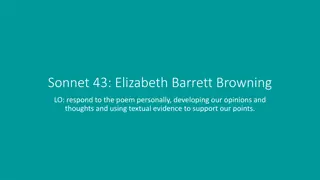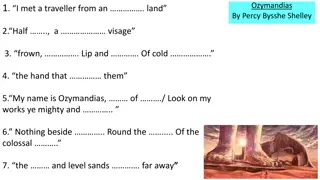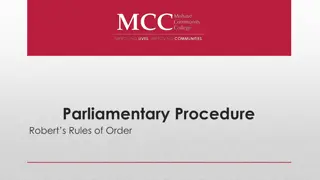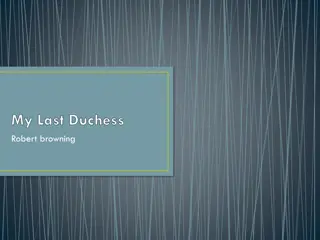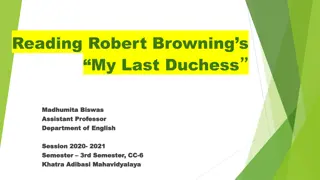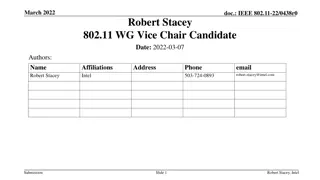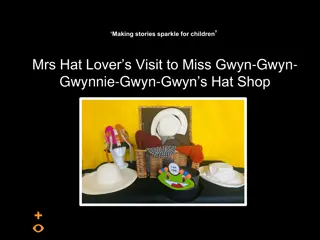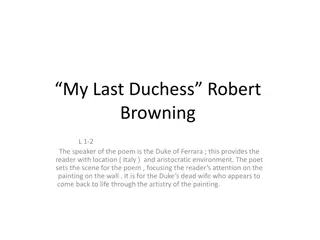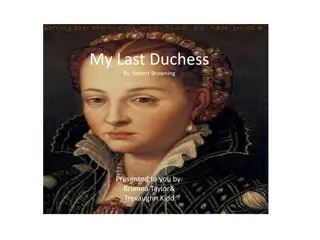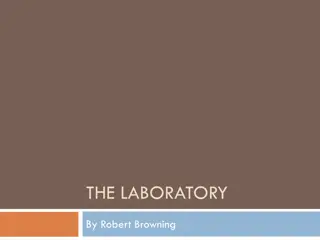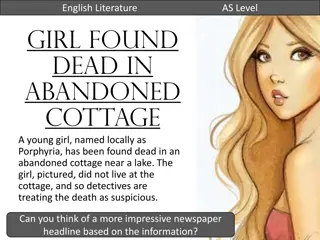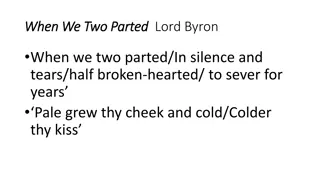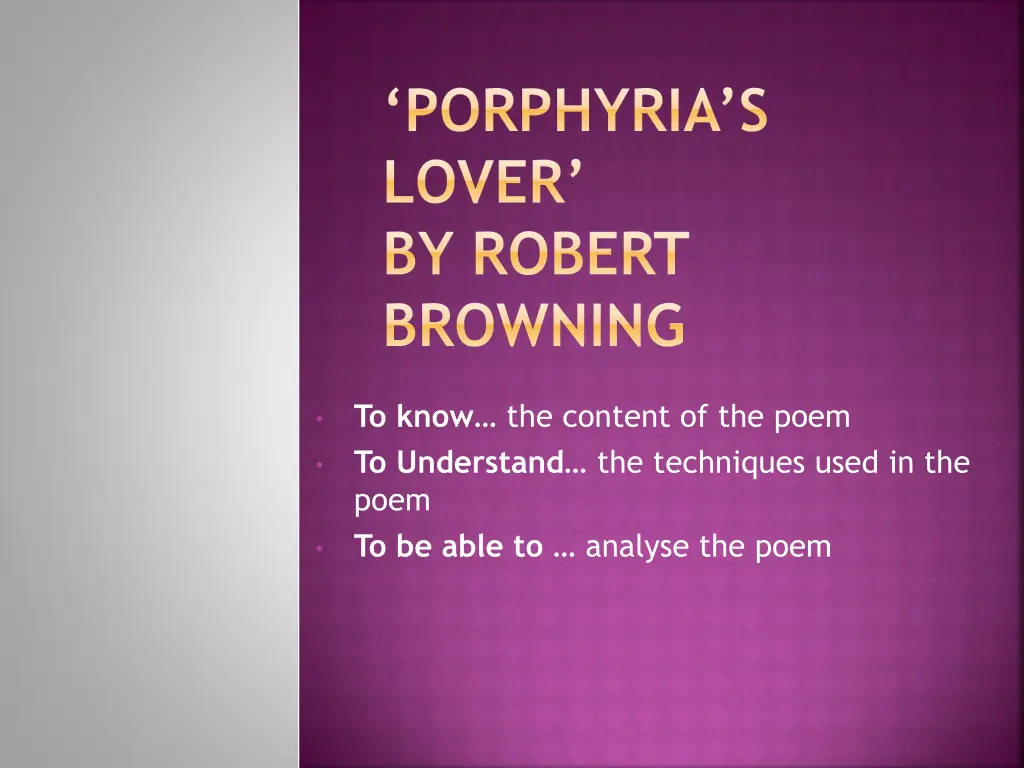
Analyzing Robert Browning's Poem 'Porphyria's Lover'
Explore the content and techniques used in Robert Browning's dramatic monologue poem "Porphyria's Lover" written in 1836. Understand the character's abnormal psychology and actions, and delve into the Victorian etiquette and key vocabulary used in the poem.
Download Presentation

Please find below an Image/Link to download the presentation.
The content on the website is provided AS IS for your information and personal use only. It may not be sold, licensed, or shared on other websites without obtaining consent from the author. If you encounter any issues during the download, it is possible that the publisher has removed the file from their server.
You are allowed to download the files provided on this website for personal or commercial use, subject to the condition that they are used lawfully. All files are the property of their respective owners.
The content on the website is provided AS IS for your information and personal use only. It may not be sold, licensed, or shared on other websites without obtaining consent from the author.
E N D
Presentation Transcript
PORPHYRIAS LOVER BY ROBERT BROWNING To know the content of the poem To Understand the techniques used in the poem To be able to analyse the poem
STARTER CONTEXT: What aspects of Victorian Etiquette (manners) are shown in these clips? Image result for victorian manners
LESSON OBJECTIVES To know the content of the poem To Understand the techniques used in the poem To be able to analyse the poem
PORPHYRIAS LOVER BY ROBERT BROWNING This poem was written in 1836. It is a dramatic monologue, in which a character, or persona , speaks to a silent listener. Browning was interested in exploring the minds of people who had an unusual or abnormal psychology in his dramatic monologues
Key Vocab READ THE POEM Porphyria The woman in the poem is named after a disease called Porphyria. It is a rare type of disease where there is a problem with the production of haem (a substance that makes up haemoglobin in our blood) within the body which can result in include abdominal pain, and problems with the nervous system and mental health. vex to annoy or anger dissever to divide or break away
PORPHYRIAS LOVER BY ROBERT BROWNING Think about the phrase dramatic monologue . What do the two words suggest to you? Read the poem through as far as the line: Murmuring how she loved me Make brief notes that record the: setting characters mood or atmosphere and any changes you notice in this. Read on to the end of the poem. Identify the point at which the most significant action occurs. What does the speaker do following this? What does he think about what he has done? Find and highlight lines from the poem that indicate that he: a) is pleased with his actions b) thinks Porphyria is happy with his actions.
PORPHYRIAS LOVER BY ROBERT BROWNING On a copy of the poem, divide it into five sections as follows: a) From the beginning to heart fit to break b) From When glided in Porphyria to And called me. c) From When no voice replied to and all in vain: d) From So, she was come through wind and rain. to And strangled her. e) From No pain felt she; to the end of the poem For each section, write a series of detailed stage directions, summing up where the scene takes place, the mood or atmosphere created, and describing the main action. For example you might start with start with: A man sits quite still, alone in a cold room in a cottage. Sound of rain and wind.
INFERENCE AND DEDUCTION To be a dramatic monologue: The poem must have a speaker and a silent listener. The reader often recognises that there is a gap between what that speaker says and what he or she actually reveals. Focus on what the poem reveals about the state of mind of the lover what he thinks, and what he believes.
INFERENCE AND DEDUCTION The lover s actual words I listened with heart fit to break What this reveals Be sure I looked up at her eyes/Happy and proud That moment she was mine, mine, I am quite sure she felt no pain The smiling little rosy head,/So glad it has its utmost will And yet God has not said a word!
USE THESE QUESTIONS TO ANNOTATE THE POEM: 1 It has a regular rhyme scheme in five-line chunks . Mark this on your copy of the poem for the first two five-line chunks. 2 Each line is also written in a regular rhythm, using the iambic pentameter form. Read the first five lines aloud, and show how the stress falls in a regular pattern of five stresses. Why has the poet used the phrase early in as opposed to the more usual construction in early ? 3 Highlight all examples of the use of and . Explain the effect of the repeated use of the conjunction and . What might this reveal about the emotional state of mind of the murderer? 4 What is the effect of the repeated references to yellow hair in the opening 20 lines of the poem? 5 Re-read the section that describes the actual murder, from: While I debated what to do. to And strangled her. How would you describe the rhythm and tone of these lines?
USE THESE QUESTIONS TO HELP YOU ANNOTATE THE POEM: 6 The form and structure of the poem creates a controlled, measured feel . What does this suggest to you about the state of mind of the persona the man who has just taken his lover s life by strangling her with her hair? 7 The poem is an account, in the form of a murderer s confession. It is not so much a whodunit as a why did he do it? As the murderer tells his story, we can start to piece together what motivated him. Search through the poem for clues as to what prompted him to kill Porpyhria. Find and annotate with a brief note of explanation, lines that could reveal that he: is passive and doesn t respond to Porphyria s affections is upset that she hasn t been willing to give herself to him fully sees Porphyria as a person to be owned or possessed thinks Porphyria is seriously ill is doing the right thing in taking her life and feels no guilt believes she is happy that she has been murdered enjoys the outcome of his actions.
CREATIVE RESPONSE Invent a new title for the poem that conveys the idea of its main theme. Support it with quotations. Turn the poem into a letter of confession. Explain what, in your judgment, motivated you to murder your loved one. In particular, explain why you think you decided to kill Porphyria at that exact moment. Write a poem in response as Porphyria what happened to you?


